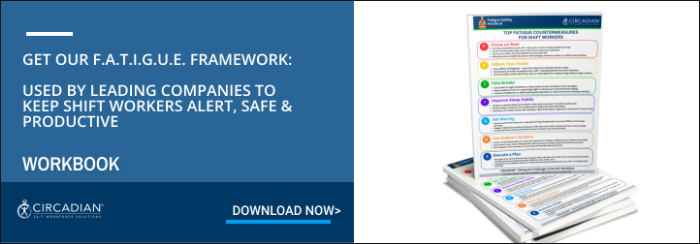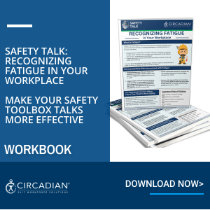Fatigue mitigation is a critical component of any safety strategy, especially in industries where extended hours, shift work, and high-stakes environments are common. Fatigue can impair decision-making, reaction time, and overall productivity, leading to costly errors and accidents. A well-designed Fatigue Risk Management System (FRMS) is essential to managing fatigue risk and ensuring operational safety. However, even the most effective FRMS systems can benefit from regular evaluation and refinement. This is where CIRCADIAN®'s Fatigue Risk Management System (FRMS) Gap Analysis tools come into play.
Whether you are looking to establish a state-of-the-art FRMS or improve an existing system, CIRCADIAN® offers expert tools to assess your current approach to fatigue mitigation. Our comprehensive gap analysis will help you identify areas of improvement and develop actionable recommendations to enhance your fatigue management efforts.
Why Is Fatigue Mitigation Important?
Fatigue is a major contributor to workplace incidents, errors, and injuries across a wide range of industries, including transportation, manufacturing, healthcare, and energy. According to the National Safety Council, fatigue is responsible for more than 13% of workplace injuries annually, costing businesses billions in lost productivity, compensation claims, and legal fees.
Fatigue mitigation strategies aim to reduce the impact of sleep deprivation, irregular work hours, and other factors that contribute to employee fatigue. By proactively addressing fatigue risk, organizations can improve safety outcomes, reduce turnover, and enhance overall operational efficiency.
CIRCADIAN®'s FRMS Gap Analysis: A Roadmap to Better Fatigue Mitigation
CIRCADIAN® has over 30 years of experience implementing Fatigue Risk Management Systems (FRMS) in diverse operational environments. Our gap analysis tool is designed to help you evaluate the effectiveness of your current system and identify areas for improvement.
What CIRCADIAN®’s FRMS Gap Analysis Can Do for You
- Numerically Rate Your FRMS Effectiveness
We evaluate how well your organization meets required or recommended industry standards for fatigue mitigation, such as ANSI-API RP 755 for the refining and petrochemical industries or FAA regulations for transportation. This helps you understand where your current system stands and whether it aligns with industry best practices. - Provide Actionable Recommendations
Based on our analysis, we’ll provide specific recommendations to bridge any gaps in your fatigue risk management system. We also establish realistic timelines and accountability structures to ensure successful implementation and improvement. - Offer a Comprehensive Evaluation
Our gap analysis evaluates a wide range of components critical to fatigue mitigation:
- Staff-Workload Balance: Ensuring that staffing levels and workloads are optimized to prevent fatigue.
- Safety Promotion: Reviewing training, education, and communication efforts to promote fatigue awareness across your workforce.
- Work Environment: Assessing workplace conditions such as lighting, temperature, and ergonomics that may affect employee fatigue.
- Individual Risk Assessment and Mitigation: Evaluating how well individual fatigue risks are assessed and mitigated in your system.
- Incident/New Miss Investigation: Reviewing how your organization investigates incidents and near-misses related to fatigue.
- Work Schedules and Hours of Service Limits: Ensuring that schedules are designed to minimize fatigue risks and comply with legal and regulatory standards.
- Continuous Improvement and Periodic Review: Evaluating your system's effectiveness over time and ensuring regular reviews and updates.
How CIRCADIAN® Conducts a Fatigue Risk Management System Gap Analysis
To conduct a thorough gap analysis of your existing fatigue mitigation strategy, CIRCADIAN® gathers data from various sources, including:
- Management Interviews: We engage with key decision-makers to understand the organization’s approach to fatigue mitigation and identify potential gaps.
- FRMS Steering Committee/Task Teams: We assess how well your fatigue management teams are functioning and whether they are adequately supporting your system.
- Physical Observations: Our team visits work areas such as control rooms, break rooms, and cafeterias to observe how employees interact with your existing fatigue risk management policies.
- Document Review: We review all relevant documentation, including your formal FRMS programs, safety protocols, training materials, and labor agreements.
- Key Performance Indicators (KPIs): We analyze relevant data to measure the effectiveness of your fatigue mitigation strategies, including accident rates, absenteeism, and turnover data.
- Payroll and Work Schedule History: We analyze historical data on employee work hours and schedules to assess the impact of shift patterns and overtime on fatigue.
The Benefits of a Fatigue Risk Management System Gap Analysis
A fatigue risk management system gap analysis offers a number of benefits to your organization, including:
- Improved Safety: Identifying weaknesses in your fatigue mitigation strategy enables you to make adjustments that reduce the likelihood of fatigue-related accidents and injuries.
- Enhanced Compliance: The analysis ensures that your FRMS aligns with industry regulations and best practices, helping you stay compliant with safety standards.
- Increased Productivity: By addressing fatigue, you can improve employee alertness, reduce errors, and increase overall operational efficiency.
- Cost Savings: Reducing fatigue-related incidents and absenteeism can lead to significant cost savings in terms of workers' compensation, insurance premiums, and legal fees.
- Better Employee Morale: An effective fatigue mitigation strategy promotes employee well-being, leading to higher job satisfaction, lower turnover, and improved morale.
Key Steps to Designing an Effective FRMS
Once you’ve completed your fatigue risk management system gap analysis, the next step is to design or refine your FRMS to incorporate fatigue mitigation strategies. CIRCADIAN® offers a range of tools and expertise to help you build an effective FRMS tailored to your specific needs.
These tools include:
- Fatigue Risk Assessment Tools: We offer scientifically validated tools to assess and measure fatigue risk in real time.
- Fatigue Awareness Training: Educate your workforce on the causes of fatigue, its impact on performance, and effective strategies to reduce fatigue risks.
- Shift Schedule Optimization: CIRCADIAN® uses advanced algorithms to optimize your shift schedules, balancing workload with employee health and safety.
- Overtime and Fatigue Risk Management: We help you manage overtime to ensure that fatigue is not exacerbated by excessive work hours.
- Fatigue Risk Informed Decision Making: We provide guidance on how to incorporate fatigue risk data into your decision-making processes, from incident investigations to staffing decisions.
Conclusion: Take Action to Mitigate Fatigue Risks Today
Implementing an effective Fatigue Risk Management System (FRMS) is essential to ensuring safety, improving productivity, and protecting your bottom line. CIRCADIAN®'s FRMS Gap Analysis tools can help you evaluate your current system, identify gaps, and create an actionable plan for improving fatigue mitigation across your organization.
By proactively addressing fatigue risk, you can reduce the likelihood of accidents, injuries, and legal challenges, while also enhancing employee well-being and operational efficiency. Whether you’re establishing a new FRMS or refining an existing one, CIRCADIAN® has the expertise and tools you need to succeed.
Don’t wait for fatigue to compromise safety or performance—contact CIRCADIAN® today to start evaluating and improving your fatigue mitigation strategies.










